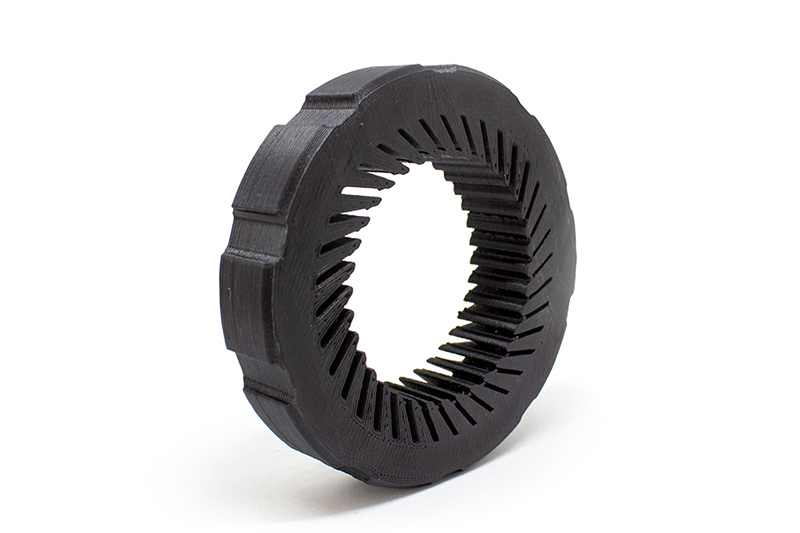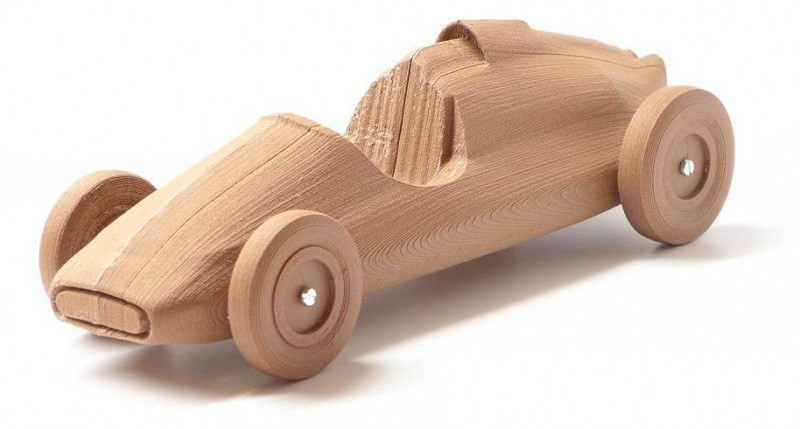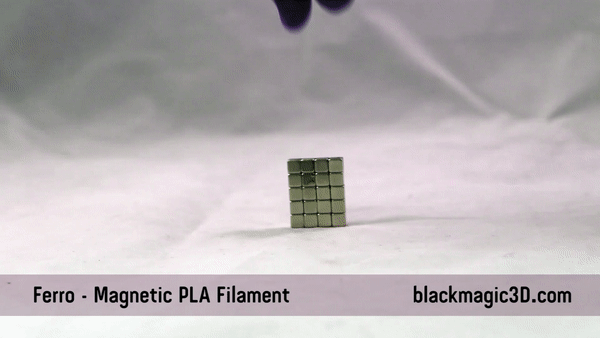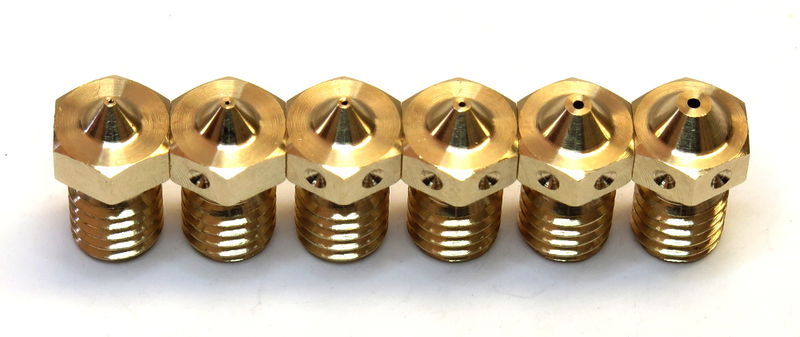
Composite filaments are becoming more and more common. These materials consist of a plastic matrix and a filler of particles or fibers. The purpose of this filler can be very varied, from increasing the final mechanical properties of the material to improving its aesthetic appearance or adding a new property such as conductivity. Thus we can find three types of composite materials:
Fiber reinforced materials
These are materials whose objective is to improve the overall mechanical properties of the matrix. The plastic matrix can be any 3D printing material, while the most commonly used reinforcements are fiberglass, carbon fiber and aramid fiber.
- Fiberglass: It provides greater resistance to tensile stresses. It has good flexibility and improves flexural strength. It provides a higher working temperature to the final material.
- Carbon Fiber: Like fiberglass, it increases tensile and flexural strength, but provides greater rigidity.
- Aramid fiber: It stands out mainly for its high resistance to impact and fatigue.
Fiber-reinforced filaments are considered technical materials and are mainly intended for the production of high-performance functional components. In general, we can find materials with loadings between 10% and 20%.

Image 1: A part 3D printed with a carbon reinforced nylon. Source: Fillamentum
The most common fiber-reinforced materials are those based on nylon, however, it is increasingly common to find other types of matrices such as ABS, PLA, PC or especially PETG.
Materials with aesthetic function fillers
These are materials loaded with various types of particles and fibers, whose main function is to vary the aesthetic finish of the base material. We can find mainly 4 types of fillers:
- Wood fibers or particles: these are materials with a high load of particles or vegetable fibers whose function is to provide a wood-like finish.
- Mineral or ceramic particles: Generally gypsum particles with different colorants. They are used to achieve finishes similar to ceramic, stone or clay.
- Vegetable fibers: Mainly used with PLA. Their function is to provide a matte finish.
- Phosphorescent particles: The most commonly used material is strontium aluminate powder, which provides a characteristic green glow. It is used in "Glow" or glow-in-the-dark filaments.

Image 2: Toy car 3D printed with PLA loaded with wood fibers. Source: Fillamentum
In general, these types of fillers are combined with a PLA matrix to maximize compatibility with all types of printers, since the aim is not good mechanical behavior, but a specific aesthetic finish.
Materials with fillers providing new properties
In some cases, the function of fillers is not to improve the properties of the matrix itself, but to provide a new physical property. The most common ones are conductivity through the use of graphene and magnetism through ferrite particles, although it is possible to find more exotic ones such as electromagnetic shielding provided by boron carbide.

Video 1: Part 3D printed with a ferromagnetic filament. Source: Protopasta
These are less common materials developed for specific applications.
Materials with metallic and ceramic fillers for sintering
These are filaments with a high metallic or ceramic powder charge, intended for the printing of parts that will later be processed by debinding and sintering treatments. In general, the matrix is composed of low-temperature materials based on PLA or waxes to facilitate debinding tasks, which can be thermal, chemical or a combination of both.
How to print filaments with fillers
Nozzle diameter selection
Some filaments with fillers require the use of nozzles with diameters greater than 0.4. In general, the manufacturers of filled filaments include in the technical data sheet the minimum recommended nozzle size, however, in case it is not specified, the following indications should be taken into account:
- Fiberglass: It is recommended to always use nozzles of at least 0.6 mm, because it usually includes large fibers.
- Carbon fiber: If the filament is specified as containing short fiber, it is likely that a 0.4 mm nozzle can be used without risk of clogging. If the filament is not specified as containing short fiber, it is recommended to start with a 0.6 mm nozzle and try using a 0.4 mm nozzle once the filament has been successfully printed with the larger nozzle.
- Aramid fiber: It is recommended to start with a 0.6 mm nozzle and try using a 0.4 mm nozzle once the material has been successfully printed with the larger size nozzle.
- Wood fibers or particles: It is recommended to always use nozzles of at least 0.6 mm, and in some cases even 0.8 mm.
- Mineral or ceramic particles: Except in those cases where the load is very high, it is generally possible to print this type of filaments with 0.4 mm nozzles.
- Plant fibers: It is recommended to start with a 0.6 mm nozzle and try using a 0.4 mm nozzle once printing with the larger size nozzle has been successful.
- Phosphorescent particles: It is generally possible to print them with 0.4 mm nozzles.
- Particles with metallic or ceramic fillers: There is usually quite a lot of variability from one material to another and even between the same material from several different suppliers. If the manufacturer does not specify a minimum size, it is advisable to always start with a 0.6 mm nozzle and try using a 0.4 mm nozzle once the material has been successfully printed with the larger size nozzle. For some specific materials it may be necessary to use 0.8 mm nozzles.

Image 3: Nozzles of different diameters. Source: E3D
Use of hardened nozzles and component wear
It should be noted that all filaments with fillers produce increased wear on hotend and extruder components, especially on the nozzle, heatbreak, extruder wheels and PTFE tubing or inserts.
Some filaments are especially abrasive, such as carbon, aramid and glass fiber filaments or metallic, ceramic and phosphorescent particles. When using these filaments it is recommended to use hardened nozzles.

Image 4: Comparison of nozzle wear with different materials. Source: 3DVerkstan
If this type of abrasive filament is used regularly, it is advisable to use, in addition to hardened nozzles, heatbreaks made of more resistant materials such as titanium and extruders with hardened steel wheels. In addition, the condition of these components, together with that of the PTFE tubes and inserts, should be checked periodically and replaced when they show signs of wear.
Printing speed and temperature
Filler-reinforced filaments have a higher viscosity than their unfilled counterparts, so it is advisable to use lower maximum print speeds. It may also be necessary to use slightly higher printing temperatures to reduce viscosity when high printing speeds are used.
Base adhesion and warping
Filaments with fillers generally suffer less shrinkage during cooling, which makes them less prone to warping. The higher the proportion of fibers or particles, the lower the shrinkage.
On the other hand, fillers also usually have an effect on the adhesion of the material to the substrate, which is slightly reduced. It is advisable to use adhesion solutions such as adhesives or lacquers when using this type of filaments, especially those with a high percentage of fillers.
Fragility of filaments
A general characteristic of particle-loaded filaments is their increased brittleness, especially those with high loading percentages or those based on PLA. This is why it is very important to position the spool properly, so that the path to the extruder is as straight and short as possible. It is also advisable to use direct extruders, although some of these filaments can also be printed in bowden printers. In the latter case it is advisable to position the PTFE tubes in such a way that they have the largest possible bending radius, as well as to position the parts at the front of the printing base.

Image 5: Spool holder placed directly on the extruder for straight feeding of the filament. Source: Raise3D
Filaments with fillers are a special category that encompasses very diverse materials, and generally require special printing configurations. This is why it is always recommended to consult all the information provided by the manufacturer and follow their printing advice.
In this guide the concepts are treated in a general way and without focusing on a specific brand or model, although they may be mentioned at some point. There may be important differences in calibration or adjustment procedures between different makes and models, so it is recommended to consult the manufacturer's manual before reading this guide.












